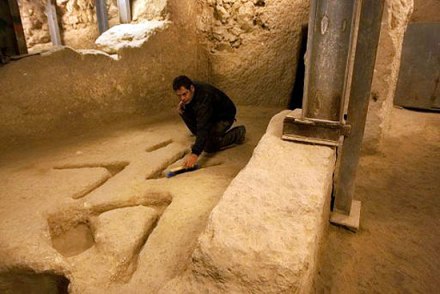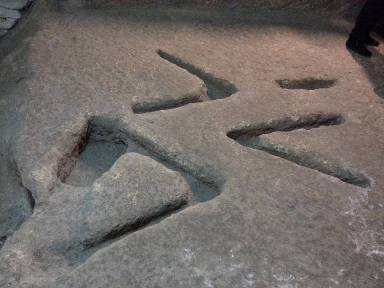
Archaeologist Eli Shukron in the newly excavated room
When Jacob fled his home in Beersheba, he slept in or near a town named Luz. That night he had dream of angels ascending and descending a ladder of stairway from Heaven. Jacob determined that this place was the House of God and named it Beth El. Jacob took the stone that he had used as a pillow and made it an upright pillar. He sanctified the pillar by anointing it with oil. The modern Israeli town of Beit El is less than five miles north of Jerusalem.
In December 2011 Israeli archaeologist Eli Shukron unearthed a room beneath the City of David. This room is in close proximity to the Gihon Spring; about thirty feet. This is important because of the association of the Gihon Spring with the Temple of God.

Archaeologist Eli Shukron in the newly excavated room
In this room was found a natural stone pillar much like the one Jacob erected at Beth El. The pillar had been placed securely in a base of stones. Eli Shukron placed a locked steel box over the pillar to protect it. This was not a random rock found in this very special room. Adjacent to this pillar is an olive press for making olive oil. This press is small and was probably for sacred purposes, and not like larger “commercial” olive presses. I believe this olive press was for the purpose of making oil to anoint the pillar.

Also, within this special place are symbols carved or engraved in the bedrock floor of the room. These symbols have mystified archaeologists since they were discovered.

I believe these “symbols” are ancient Hebrew letters. Below are two examples of the Hebrew letter “Beit.” The left beit is from the time of Moses. The one of the right is from the inscription found in Hezekiah’s Tunnel, which was used to channel the water from the Gihon Spring. The tunnel inscription is mere feet from the special room.



The next group of “symbols” is more difficult. I believe that together they represent the Hebrew letter “yod,” which corresponds to our English letter “J.” Here are some examples of Paleo-Hebrew yods. The yod on the left is from early Hebrew writings. The one in the center is again from Hezekiah’s Tunnel. On the right is the Nordic rune (letter) corresponding to our “J.” I give this as an example of another ancient alphabet. I believe that all alphabets are derived from Hebrew, which I believe to be the original alphabet and language.



Here is the Paleo-Hebrew yod, inverted one-hundred, eighty degrees, compared with the letter found carved in the floor.

The Hebrew yod is the first letter in the name of God, JHWH, translated as LORD in the King James Version. The Lord’s name is called “Jah” in Psalm 68:4 and begins with a yod. When we say “Hallelujah” we are saying “Praise God.”
The archaeologists are convinced that the pillar is of Hebrew origin, and not from the pagan Jebusites who lived here before King David conquered the city. Possibly they believe this because there is no inscription on the pillar.
Because I believe the Temple of God was built in the City of David, near the Gihon Spring, I strongly suspect that the Temple was built over this very special place. Eli Shukron reports that the room had been filled with layers of stones and dirt. This was done purposefully. The fill is not the detritus of the ages. The archaeologists believe it was filled for support so that a defensive wall could be built above it. I wonder if it was not the wall of the Temple that was built above it.
I am convinced, in my amateur archaeologist way, that this is a precious, holy place. I believe the carving in the floor indicates that this is the House of God (Beit Yod – Beit Jah), and a later House of God was built above it.
Some have expressed the idea that this was where Melchizedek, king of Salem (later known as Jerusalem) and priest of God Most High, met Abram, later renamed Abraham. (Genesis 14:18-20) It is no stretch of the imagination that Melchizedek worshipped the Lord in this very spot.
I feel very sure that the room found by Eli Shukron is a very special, and holy, place. I believe it is the location of the House of God. What a privilege and blessing to have stood in that very place.
This is the original article I wrote and sent to the members of the tour group who were with us in Israel. One of the group sent this to Dr. William Welty, Director of the ISV Foundation and knowledgeable of ancient languages. Dr. Welty replied, "Mr. Taylor is correct." (!!!) In his opinion, Dr. Welty believes the "mysterious markings" say, "House of God."
Wow! And again,Wow!
BACK to House of God Page.